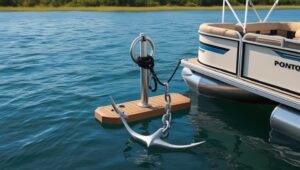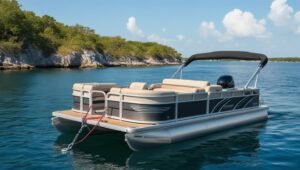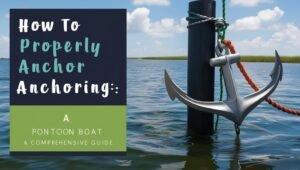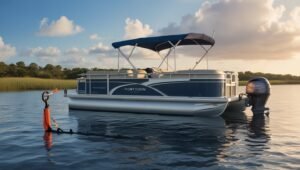
How to properly anchor a pontoon boat a comprehensive guide
Anchoring a pontoon boat may seem like a simple task, but it requires careful attention and proper technique to ensure your boat stays safely in the water. Whether you’re new to boating or a seasoned captain, understanding the intricacies of anchoring will help you avoid common pitfalls and ensure a safe and enjoyable experience on the water. In this guide, we’ll explore everything you need to know about how to properly anchor a pontoon boat.

Why is proper anchoring important?
Before diving into the step-by-step process of anchoring, it’s important to understand why proper anchoring is important to pontoon boat owners.
Safety Proper anchoring prevents your boat from drifting away, which can lead to accidents or collisions with other vessels, rocks, or shorelines.
Stability A well-anchored boat stays in place, ensuring that it remains stable even in changing weather conditions.
Comfort Proper anchorage keeps your boat stable, allowing you and your passengers to relax, fish, or enjoy water activities without constant adjustments.
Protecting the marine environment Proper anchoring helps prevent damage to sensitive marine ecosystems, such as coral reefs and seagrass beds, which can be damaged by improper anchoring techniques.
Choosing the Right Anchor for Your Pontoon Boat
Choosing the right anchor is the first step in ensuring your pontoon boat stays securely in place. Here are some factors to consider when choosing an anchor:
Anchor Type
Fluke Anchor (Danforth) Ideal for sandy or muddy bottoms, this anchor is lightweight and provides excellent holding power.
Plow Anchor Best suited for a variety of bottom types including sand, mud and gravel. Its shape allows it to dig in and hold firmly.
Mushroom Anchor Suitable for soft bottoms, this anchor provides good holding power in mud and silt but is not recommended for rough waters.
Anchor Weight The weight of the anchor should be proportional to the size of your pontoon boat. A heavier anchor may be required in areas with strong currents or strong winds.
Anchor Ride The ride is the line or chain that connects the anchor to the boat. A combination of rope and chain is often recommended, with the chain providing additional weight to set the anchor properly.
Bottom texture Understanding the type of bottom where you will be anchoring (sand, mud, rock, etc.) will help you select the most effective anchor for that environment.
A step-by-step guide to anchoring a pontoon boat
Now that you’ve chosen the right anchor, let’s go through the step-by-step process of anchoring your pontoon boat.

1 Choose the right location.
Avoid dangerous areas: Find a place away from other boats, rocks, or shallow areas where your boat could capsize.
Consider the wind and current: Position your boat so that the bow points into the wind or current. This orientation helps the anchor to dig in and hold better.
2 Prepare the anchor and ride.
Check the road length: A general rule of thumb is to have a scope (ratio of ride length to water depth) of 5:1 to 7:1. In difficult situations, a higher scope may be required.
Secure the ride: Attach the ride to one of your boat’s cleats, making sure it’s securely fastened before lowering the anchor.
3. Lower the anchor.
Lower, don’t throw: Lower the anchor gently rather than throw it into the water. Throwing the anchor may cause it to become tangled or not set properly.
Pay out the ride: As the anchor comes down, pay out the ride slowly, allowing the anchor to reach the bottom.
4 Set the anchor
Reverse slowly Once the anchor is down, reverse the boat slowly to help the anchor dig in. You will feel resistance as the anchor sets.
Check the Hold After the anchor is set, put the boat in neutral and observe the surroundings. If the boat drifts, the anchor may not be set properly, and you may need to reset it.
5 Secure the boat
Monitor the position of the boat: Even after the anchor is set, it is important to check the position of the boat from time to time to ensure that it is not drifting.
Adjust as needed If conditions change, such as increased wind or current, you may need to ride more or change anchor locations.
Common Mistakes to Avoid When Anchoring
Anchoring may seem straightforward, but there are common mistakes that can lead to problems. Here’s how to avoid them
Using the wrong type of anchor Make sure the anchor you choose is suitable for the substructure where you will be anchoring.
Inadequate scope Not allowing enough ride out can prevent the anchor from setting properly. Always make sure you have the right scope for the situation.
Failure to set anchor Simply dropping anchor is not enough. You must capsize the boat to make sure the anchor digs in and holds.
Not monitoring the boat’s position After anchoring, always check that the boat remains stationary. If it drifts, reset the anchor immediately.
Anchoring too close to other boats Give yourself enough space from other boats to avoid collisions, especially if the wind or current shifts.

Tips for Anchoring in Different Situations
Anchoring a pontoon boat can vary depending on the environment and weather conditions. Here are some tips for specific situations
1 To anchor in strong winds or currents
Use two anchors In strong winds or currents, consider using two anchors set at a 45-degree angle from the bow. This technique provides additional holding power.
Increase the scope In rough conditions, increase the scope to 7:1 or more to ensure anchor retention.
2 Anchoring in shallow waters
Use a light anchor: In shallow waters, a light anchor may be sufficient, but make sure it is suitable for the type of bottom.
Check for tidal changes Be aware of tidal changes that may affect water depth and adjust your anchoring accordingly.
3 Anchoring in rocky or coral areas
Avoid Sensitive Areas: Avoid anchoring in coral reefs or rocky areas to avoid damaging the environment and your anchor.
Use a snubber A snubber is a piece of line attached to the ride that absorbs shock and reduces stress on the anchor in rough conditions.
Proper anchor retrieval
Once you’re ready to move, proper anchor retrieval is just as important as setting it up. Here’s how to do it:
Approach the anchor slowly: Move the boat slowly toward the anchor, slowing the ride as you go.
Break the Anchor Free Once directly above the anchor, gently pull the rider to break the anchor from below.
Raise the anchor Carefully raise the anchor by hand or using a windlass, making sure it does not scrape the boat’s hull.
Clean the anchor Once on board, clean the anchor and ride to remove any mud or debris.

The result
Properly anchoring a pontoon boat is an essential skill for any boat owner. By choosing the right anchor, practicing proper anchoring techniques, and avoiding common mistakes, you can ensure a safe and enjoyable experience on the water. Whether you’re anchoring in calm waters or rough conditions, the steps in this guide will help you anchor your pontoon boat correctly ev
ery time.
